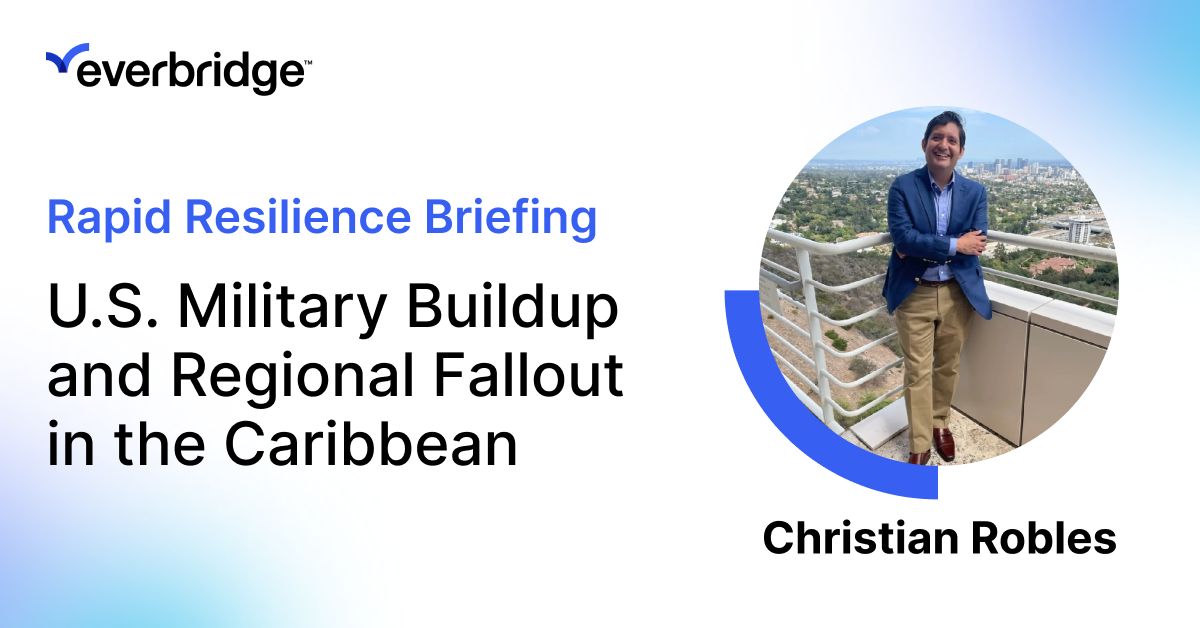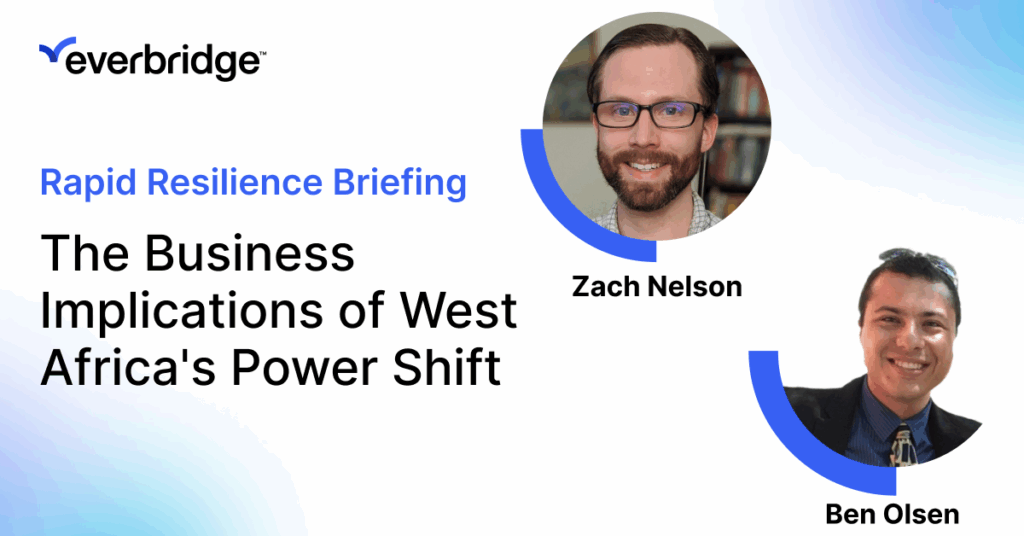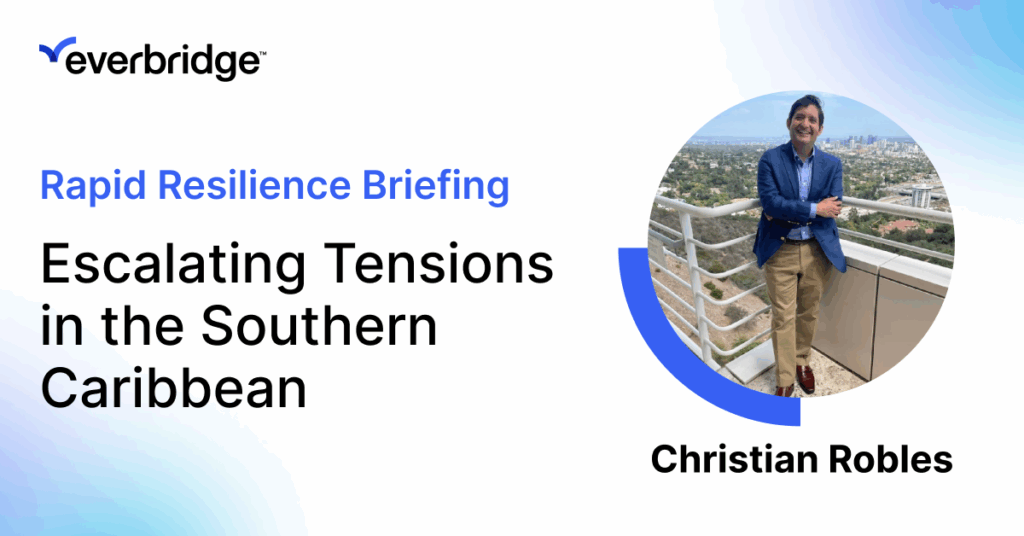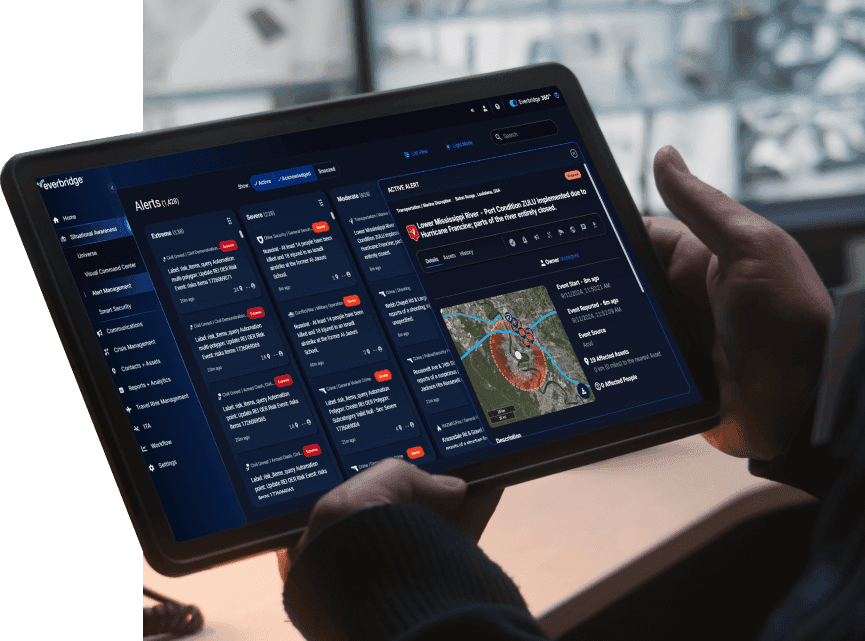Full transcript
00:05
Hello, my name is Christian Robles and I’m the regional analyst for Latin America in the Caribbean here at Everbridge. We’ve been following this story since mid August when reports first surfaced that the US was deploying naval and air assets into the southern Caribbean.5sAdd a noteJump to
00:22
Early positioning framed as a counter narcotics buildup against so-called narot terrorists in the region. Two months later, that buildup has become a live operation. The US has now conducted 10 confirmed strikes. Eight in the Caribbean Sea and two in the Eastern
00:40
Pacific, killing at least 43 people and capturing two others. The latest strike hit a Drenad Aagua vessel in international waters. And hours later, Washington ordered the deployment of the Gerald R. Ford carrier strike group into the region under US southern command.
01:02
This marks a turning point. What began as targeted interdictions is now a full-scale power projection in the Western Hemisphere. And looking ahead, if this continues, several outcomes are possible. First, the operation could expand beyond the sea. President Trump has said he
01:22
won’t seek a declaration of war and that land operations will be next. That raises the prospect of covert actions inside Venezuela or air strikes on inland targets. Redrawing the map of US engagement in South America. Second, regional alignment is hardening. Colombia accuses Washington of
01:45
extrajudicial killings while Venezuela is mobilizing forces along its borders and warning of asymmetrical warfare. Meanwhile, Trinidad and Tobago is moving the other direction, hosting the destroyer USS Graveley and 2,000 Marines this week for joint exercises. The
02:05
island has become Washington’s southern anchor, a forward partner now facing greater exposure to Venezuelan cyber and intelligence pressures. And third, the commercial impact for shipping energy and insurance. The southern Caribbean is shifting from a patrol zone to a contested operating environment.
02:29
It’s expected temporary port closures in Trinidad and Tobago, higher war risk and detention premiums within 200 nautical miles of Venezuelan waters and strict sanctions screenings as the US expands terror designations. If exclusion zones appear or if Venezuela begins shadowing commercial
02:49
traffic, markets will react quickly. Since August, this campaign has evolved from deterrence to execution. The language deployments and now the carrier group all signal a sustained operational phase. If the tempo continues, the next step could move Finland. A shift that would
03:09
rattle regional stability and the confidence of US companies moving goods, fuel or data through these routes. We’ve been covering this from all angles and the takeaway is clear. We recommend monitoring unfolding events. Each new strike, asset movement signals that this
03:30
operation isn’t slowing, and the longer it runs, the harder it becomes to unwind. I’m Christian Robas, and we’ll continue tracking how these developments shape risk and stability across the region in the days ahead.
In our latest Rapid Resilience Briefing, we analyze the new phase-one Gaza ceasefire, a fragile starting point but not a complete peace plan.
Full transcript
[[00:05.0]
Hello, my name is Zsolt Csepregi. I’m the regional, analyst for the Middle east and North Africa at Eberbridge’s Global Insights Team. Today I will outline the ceasefire deal between Israel and Hamas and highlight the associated security and business risks. The newly announced Gaza ceasefire, which was brokered by the United States, Egypt, Turkey and Qatar, is a phase one agreement which is designed to secure the release of Israeli hostages in exchange for Palestinian prisoners, assured limited withdrawal of Israeli forces from Gaza and expanded humanitarian aid access.
[00:39.4]
It’s an important step, but it’s not a solution. Mediators themselves call it a starting point. A narrow humanitarian and political transaction, but not a complete peace plan. The goal right now is simple, to stop the immediate fighting and get the Israeli hostages home.
[00:55.9]
Everything beyond that, from Hamas disarmament to the future of Gaza’s governance, remains deeply contested. The second phase, meant to turn this truce into a sustainable political settlement, will be much harder. Israel insists that Hamas must be disarmed and excluded from the governance of Gaza.
[01:14.9]
While Hamas for its part, refuses to surrender control or its legitimacy. These positions are fundamentally incompatible once the immediate pressure eases. So the Israeli hostages are home and Israeli troops pull back, both sides will have far less incentive to compromise.
[01:34.7]
External actors are also shaping this trajectory. Palestinian Islamic Jihad has cautiously accepted the deal, but there is still a risk that more militant elements within Hamas or BIG could splinter towards Islamic State aligned, groups that outrightly reject any form of political compromise with Israel.
[01:55.6]
The Houthis in Yemen continue to reject the ceasefire outright, keeping Red Sea maritime risks elevated, while Hezbollah remains deliberately ambiguous along the northern border of Israel. For businesses and international operators, this environment represents de escalation without guaranteeing a resolution.
[02:15.4]
It’s a reduction in immediate violence, but not in underlying instability. So logistics and air travel are likely to remain volatile with potential disruptions from renewed rocket fire, drone attacks or political protests.
[02:30.5]
And beyond the region, pro Palestinian and pro Israeli demonstrations will continue across major global cities, carrying reputational and operational risk for multinational firms. Global companies should therefore remain vigilant and adaptable as this first phase of the ceasefire unfold and negotiations on the second phase start.
[02:51.0]
Even if progress continues, instability will persist across the Middle East. Organizations should diversify logistic routes, review travel and security protocols and maintain flexible staffing and crisis communication plans. Monitoring both of regional developments as well as protest movements globally will be key in protecting personnel and operations.
[03:12.8]
The coming months will demand strategic patience coupled with operational flexibility as the ceasefire talks may reduce violence temporarily but are far from assuring a lasting stability.
In our latest Rapid Resilience Briefing, Christie Majoros explains how the current U.S. government shutdown differs from previous ones with little compromise in sight.
Full transcript
[00:04.9]
Hello, my name is Christie Majoros. I am the Regional Analyst for North America on Everbridge’s Global Insights team. And today I’ll be giving a brief update on the current government shutdown, which is in its seventh day after starting on October 1st. At this time, there is little indication of the compromise in voting which would end the current shutdown and reopen the government.
[00:24.7]
And this is seeming unlikely to happen today or perhaps even this week. Government shutdowns are nothing new. We saw them during the previous Trump administration, and we saw them during the Obama administration. Like previous shutdowns, this current shutdown is causing many of the same problems in the halting of the disbursement of federal funding and also in the furloughing of the federal employees that run federal agencies.
[00:52.7]
However, unlike previous shutdowns, which were a temporary pause on government processes, this current shutdown has been seized upon as an opportunity for the administration to reallocate federal resources so that they are more in keeping with current executive priorities.
[01:14.5]
We’re seeing this happen in two ways. First, in the withdrawal or the cut to federal funding for certain projects. We’ve seen this, for major infrastructure projects in New York and Chicago, and also for clean energy projects in at least 16 other states to date.
[01:36.7]
Second, the President has announced that there are likely to be further personnel cuts to federal agencies. At this time, those agencies have not been named specifically. However, taking into account current executive priorities and the cuts made to federal agencies earlier this year, we might surmise that these are agencies that will be related to civilian, regulatory or science matters.
[02:04.2]
However, this remains to be seen. So what does this mean for businesses? Well, like any shutdown, this largely puts a pause on the government processes that interact with businesses. However, unlike a typical shutdown, whose effects would be temporary, this shutdown will have a reshaping effect on the federal government.
[02:28.9]
This means that many sources of federal funding or federal processes may not resume after the shutdown is resolved. And this will have a big impact on which industries will be able to grow and which will find this more difficult in the post shutdown period.
[02:48.9]
For right now, in addition to the practical problems created by this shutdown, there’s also this large uncertainty, in a situation which is very high stakes and increasingly volatile. So what can businesses do to mitigate?
[03:04.7]
Well, they can strengthen cash reserves, they can look beyond federal contracts, and they can stay alert to policy shifts, so that they can quickly adjust if funding or regulations change. In short, they can be prepared, they can keep an eye on the situation and be prepared for the possibility of a long term disruptive change.
In our latest Rapid Resilience Briefing, James Burr, discusses the surge in antisemitic violence in Europe.
Full transcript
[00:05.0]
Hello everyone. Thank you for joining. My name is James Burr and I’m the Senior Regional Analyst for Europe Caucuses and Central Asia. I want to give you a quick briefing on an ongoing security risk, rising antisemitic violence across Europe with a focus on the recent attack outside the synagogue to the north of Manchester in the UK.
[00:24.6]
On October 2 during Yom Kippur A car ramming and stabbing outside the Heaton Park Hebrew Congregation killed two worshippers and injured several others. This was the most severe antisemitic attack in Europe so far this year, and authorities immediately labeled it an act of terrorism.
[00:42.9]
The timing on the holiest day in the Jewish calendar underscored the deliberate symbolic nature of the violence. But this isn’t an isolated event. Since the onset of the Gaza war in 2023, we’ve seen a surge in antisemitic violence, vandalism and intimidation across Europe.
[01:00.0]
And this trend has continued as we approach the second anniversary of that conflict erupting. In the UK alone, there are about 1,500 incidents recorded in just the first half of this year, an extremely high figure. France and Germany are also seeing similar patterns with attacks on synagogues, schools, Jewish leaders and cultural sites being reported this year.
[01:20.7]
Even smaller Jewish communities like those in Switzerland are being targeted. So why does this matter now? The Manchester attack highlights how antisemitic sentiments are manifested in acts of targeted violence. It also raises the risk of copycat incidents, particularly around Jewish holidays, or at high profile institutions.
[01:42.2]
Security services are responding with stronger patrols, but the overall threat environment remains elevated and geographically dispersed across much of Europe. For businesses or institutions directly impacted by these antisemitic attacks on their premises or in the vicinity, there are several implications.
[02:01.8]
Operations may be disrupted by lockdowns and road closures near attack sites. There are also knock on effects for supply chains, corporate travel security, insurance costs and even legal liability if firms fail to meet duty of care obligations.
[02:18.4]
Looking ahead, we assess with moderate to high confidence that antisemitic violence will stay elevated across Europe into 2026, with spikes during Jewish holidays and at moments of geopolitical tension. So what can organizations do? A few key resilience measures include upgrading site security, running vehicle ramming and active attacker drills, using real-time intelligence and alerting systems, and strengthening communication plans.
[02:47.5]
Partnerships with local law enforcement and geo security organizations are also critical, as are reviews of insurance and legal protections. In short, this is a sustained and regional trend that businesses and communities alike are encouraged to prepare for, not just an isolated crisis.
Full video transcript
00:01
[Music] Hey, good afternoon everybody. My name is Ed Luke. I’m the director of risk intelligence and strategy here at Everbridge. I just wanted to discuss a situation that happened yesterday outside of New York City where the United States Secret Service dismantled a clandestine telecommunications
00:20
network. The network comprised of 300 plus SIM card servers and over 100,000 SIM cards spread across five locations. So, why does this matter, right? Why does anybody care? Law enforcement says the hardware could have been used to threaten US officials, carry out
00:35
encrypted and anonymous communication, disrupt cell communications, shutting down cell phone towers, and obviously possibly interfere with emergency communications. Also, for good measure, law enforcement also obtained many illegal firearms, some cocaine and encrypted tools as well. So, no suspect
00:55
has yet been identified, but intelligence sources do suggest that the potential for involvement of a nation state actor is very real. Nation state actors have been attacking and trying to leverage gaps in United States infrastructure for years. Uh lately, the Chinese and Russian governments have
01:11
ramped up their cyber attacks against the water sector, the electricity sector, the financial sector, the health sector as well. You know, a lot of the infrastructure in this country is aging and it’s susceptible to not only sophisticated attacks like this one, but
01:25
lowcost minimal planning attacks that we’ve discussed many times when talking about domestic violent extremists. So, of course, the timing of all this is very interesting being that the UN is meeting in New York City and it just highlights a lot of risks and vulnerabilities uh that that companies
01:41
should be aware of. This is a hybrid threat. You know, cyber electronic conventional counter intelligence operations. This changes the threat vector. You know, complicates your ability to mitigate and leads to confusion. Obviously, in crisis or attack, a loss of communications even
01:57
temporarily will degrade your command and control, your ability to coordinate, and your ability to respond. uh interference of communications during a high-profile diplomatic event could escalate into other cascading security failures and physical security and executive protection. It highlights the
02:14
gap and lack of redundancies in people’s communications and their security. The sophistication and scale of this uh leads to the fact that looks like a nation state actor or some other well-funded elicit actor are other areas other sectors like health or electricity
02:33
at risk. Uh could this happen in other high-profile metro areas like Washington DC? Uh obviously it could. Are those operations actually in place right now? Uh too early in the investigation to be able to tell. Um, you know, this potential attack seems very daunting.
02:50
Uh, you know, the impacts would be massive. Uh, but there are a few things that I would consider. Uh, if I were running an organization right now, I would audit my telecom dependencies. What depends on cell and SIM services? What go through those channels? What if
03:04
that’s unavailable? Uh, establish backup communications, satcoms, mesh radio, HF radio, is additional ISP paths. Uh, it might sound primitive. Uh but then again, so is not being able to communicate to your assets and your people uh during a crisis. Also, I look at deploying anomaly detection. Uh work
03:24
with your carriers to monitor unusual loads. Uh monitor for strange traffic or spikes in encrypted communications. Use AI and ML. Leveraging those for detection, anomaly detection, monitoring, and alerting is is key for early warning. Uh I would enforce device control. uh SIM inventory, keep a tight
03:43
control over your SIM cards, uh make sure unused ones are decommissioned, exercising, simulate comms, outages, practice your business continuity. How should your team react and respond to one of these incidents, then adjust accordingly? And then also equally important is liazing with private and
03:59
public sector partners, law enforcement, telecom providers. You know, build relationships and share information. Intelligence and information sharing uh leads to better security, improves risk posture. So, those are just a few things you could do in the event uh or to limit
04:13
your exposure in the end of event of one of these attacks. You know, here at Everbridge, we’ll continue to monitor this situation and provide updates as they come on this and all other risks out there. So, reach out if you need anything. I appreciate your time. Have a great rest of your afternoon.
Join Everbridge to explore the evolving political and economic landscape in West Africa, focusing on the emergence of the Alliance of Sahel States (AES) and its implications for global businesses.
In our latest Rapid Resilience briefing, Everbridge Expert James Burr, breaks down the latest on the drone strikes in Poland that happened in the early hours of September 10.
In our latest Rapid Resilience Briefing, Christian Robles, Everbridge’s Regional Analyst for Latin America and the Caribbean, breaks down the fast-evolving situation in the southern Caribbean.
Adam DeLuca discusses the Fort Stewart incident, insider threat programs, and strategies to detect, prevent, and respond to risks.










